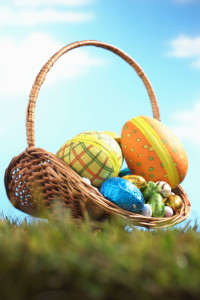 There are many different ways to celebrate Easter, which falls on April 5 this year. Like Christmas, the holiday has become highly commercialized; for many people it is about chocolate bunnies, colored eggs and jelly beans. For Christians, Easter is the oldest and most important religious holiday of the year and celebrates the resurrection of Jesus Christ.
There are many different ways to celebrate Easter, which falls on April 5 this year. Like Christmas, the holiday has become highly commercialized; for many people it is about chocolate bunnies, colored eggs and jelly beans. For Christians, Easter is the oldest and most important religious holiday of the year and celebrates the resurrection of Jesus Christ.
Date of Easter
Easter Sunday falls on a different day each year sometime between March 22 and April 25. The exact date is connected to the moon’s cycle. The rule is that the holiday takes place on the Sunday after the first full moon or vernal equinox, which marks the beginning of spring. Good Friday, the day Christ died on the cross, is the Friday before Easter. Easter Sunday also commemorates the end of Lent, the 46-day period that begins on Ash Wednesday. Fat Tuesday, also known as Mardi Gras, is the day before Ash Wednesday. Places such as New Orleans, Rio de Janeiro and Venice acknowledge the occasion with parties and other celebrations before Lent begins. Lent is traditionally a much more somber time in the church.
Bunnies and Eggs
The Easter bunny it not a recent creation and has been around for hundreds of years. It originated from an Anglo-Saxon pagan festival celebrating the goddess of spring, Eastre. The Anglo-Saxons glorified her earthly symbol, which was the rabbit. Over the years, the name of the holiday has evolved from “Eastre” to “Easter.”
Easter eggs are not modern inventions either. The egg has traditionally been a sign of rebirth. For centuries, people have exchanged them in spring. The wealthy sometimes wrapped them in gold leaves and peasants would color them from dye made by boiling certain kinds of flowers and leaves. Some early Christian communities dyed eggs red in remembrance of Christ’s blood that was spilled during his crucifixion.
Fabergé eggs are some of the most expensive and exquisite Easter eggs ever made. Peter Carl Fabergé and his company designed them for the Russian Imperial Court between 1885 and 1917. The eggs were covered in jewels, and the Russian Tsars gave them to their mothers and wives as Easter presents. There were approximately 50 eggs made, 43 of which are known to still exist. They are now worth millions of dollars and are owned by museums and private collectors around the world.
Easter Celebrations Around the World
- United States
Protestants and Catholics in the United States (and worldwide) typically celebrate the holiday by attending church. Women sometimes wear decorated hats to the service. It is also customary to have an Easter feast; lamb and ham are two popular choices for the main course. Parents often hide Easter baskets full of treats, including chocolate bunnies and jelly beans, for their children. The President and his family always host an Easter egg hunt on the lawn of the White House the Monday after Easter.
- Bermuda
Bermuda is one of the top producers and exporters of Easter lilies—lovely fragrant white flowers that are popular Easter decorations. Many people also fly homemade kites in Bermuda on Easter. The story behind the tradition is that a Sunday school teacher had a hard time explaining Christ’s ascent to Heaven. He made a kite, which is usually shaped like a cross, to demonstrate how it happened. It is also customary for Bermudians to eat hot cross buns and fish cakes on Easter.
- Haiti
In Haiti, Holy Week—which is the seven days leading up to Easter—is celebrated with a mix of voodoo and Catholic traditions. There are parades and people play drums, trumpets and sometimes coffee cans. Devout voodoo practitioners also make animal sacrifices to the spirits in the village of Souvenance.
There is a wide variety of ways to celebrate Easter. If nothing else, it is a sign of spring that is welcomed by many people worldwide.

